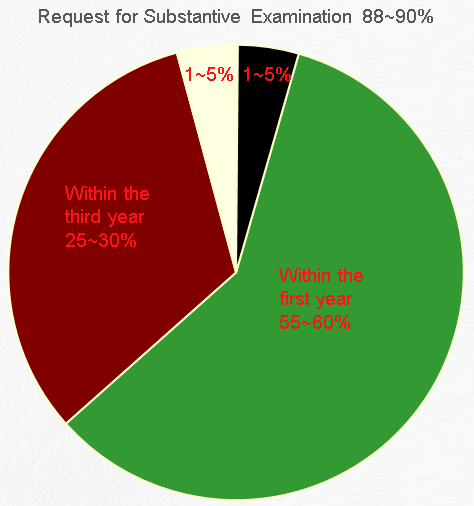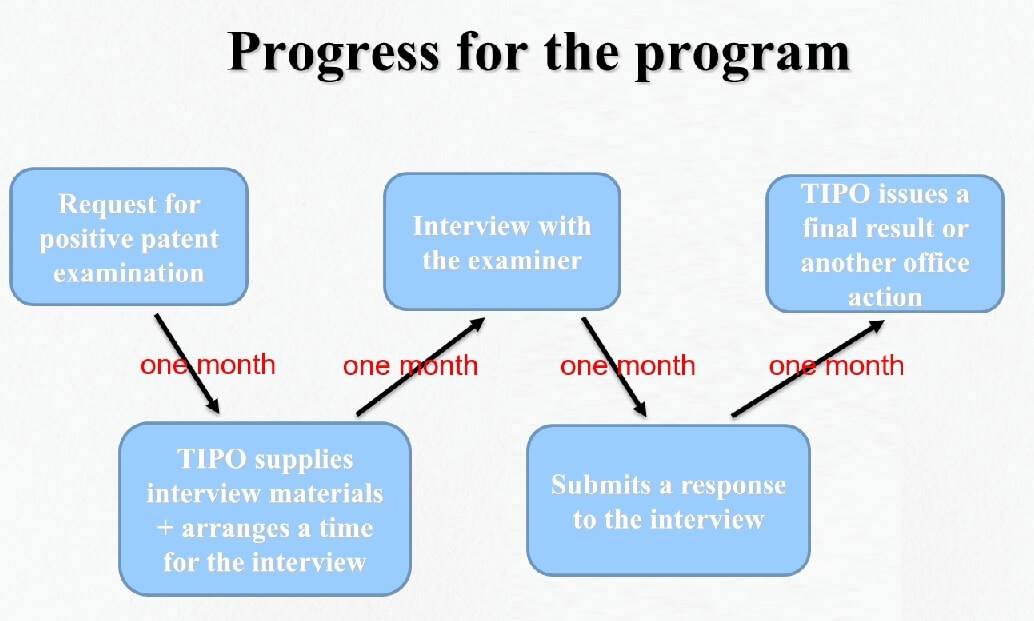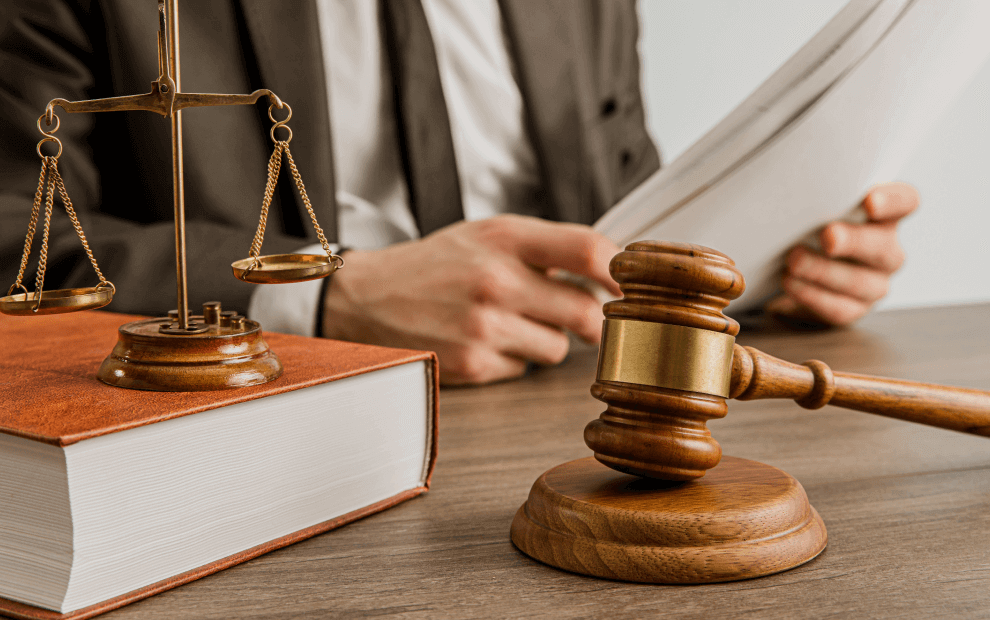More Details
The Taiwan Intellectual Property Office (TIPO) provides several ways to accelerate the patent prosecution procedure, and applicants may request accelerated examination based on the nature of the patent application and their requirements. This article will discuss different ways to accelerate the patent prosecution in Taiwan and offer tips about how and when such request should be filed.
The ways to accelerate the patent prosecution in Taiwan include:
- Request for substantive examination
- Request for prioritized examination
- Request for an interview with the examiner
- Request for accelerated examination under the Patent Prosecution Highway (PPH) Program
- Request for accelerated examination under the Accelerated Examination Program (AEP)
- Request for Positive Patent Examination Pilot Program
Request for Substantive Examination
In fact, the most important factor that affects the time frame of the prosecution of a patent application is the timing of requesting substantive examination. It should be noted that for an application for which the substantive examination request was filed simultaneously with the application in comparison with an application for which the substantive examination request was filed after three years, there is a significant three-year difference. That is to say, the most effective way to speed up the prosecution would be filing the substantive examination request as soon as possible.
However, out of several concerns, applicants might postpone the timing to request substantive examination. Deciding factors are, for example, the costs generated from requesting substantive examination and the subsequent procedures relating to office actions and responses, uncertainty regarding whether the patent is profitable, especially during the early stages of development, or whether the patent application is patentable with regard to the novelty and inventive step requirements.
The following figure shows when applicants decided to file the request for substantive examination. It can be seen that for about 55~60% of the applications the request was filed within the first year, for about 25~30% of the applications the request was filed within the third year, and for only less than 5% of the applications the request was filed within the second year or after three years.

Therefore, there is no definite answer as to when to file the request for substantive examination. The decision should be made based on each company's individual strategy and policy.
Request for Prioritized Examination
Article 40, Paragraph 1 of the Patent Act states,
“The Specific Patent Agency may upon request conduct prioritized examination of a patent application for invention if it is commercially exploited by a person other than the applicant after it is laid open.”
Accordingly, if an applicant intends to request prioritized examination, the invention should be commercially exploited by a person other than the applicant after it is laid open. Further, the request for prioritized examination can only be filed after, or at least simultaneously with, the request for substantive examination. In addition, this request can not only be filed by the applicant but also by the person who commercially exploits the invention.
However, this article does not apply if the applicant itself commercially exploits the invention. In such case, the applicant may consider requesting accelerated examination under the Accelerated Examination Program, which will be discussed below.
Request for an Interview with the Examiner
Generally speaking, it is not necessary to file a request for an interview at all stages. However, after receiving one or several office actions, especially during re-examination (might be the last chance to file a response), the applicant may consider filing this request.
The benefit is that the applicant may explain the patentability of the claimed invention to the examiner in person, or at least get a better understanding about how to overcome the issues raised by the examiner, for example, how to amend the claims or how to supplement the argument to ease the examiner’s doubt, thereby speeding up the prosecution.
Request for Accelerated Examination under the PPH Program
Currently, TIPO provides the PPH Program between Taiwan and the US, Taiwan and Japan, Taiwan and Korea, Taiwan and Spain, as well as Taiwan and Poland. Taking the PPH Program between TIPO and USPTO as an example, there are several requirements that should be met when requesting the PPH Program:
Requirements for the PPH Program between TIPO and USPTO
1. The request should be filed after receiving the notice that the application is undergoing substantive examination and before receiving the first office action;
2. At least one corresponding US application has one or more claims that have been determined to be patentable by the USPTO;
3. All claims on file, as originally filed or as amended, for requesting PPH must sufficiently correspond to one or more of those claims indicated as allowable in the USPTO;
4. The TW application is (i) an application which has validly claimed priority to the US application(s), or (ii) an application which has validly claimed priority to the PCT application(s) without priority claim, designating US as the priority case.
As can be seen clearly, it is quite strict to request for the PPH Program. However, if the application meets all requirements for PPH Program, such Program might be the most effective way to accelerate the prosecution.
Request for Accelerated Examination under the AEP
The AEP request should be filed after receiving the notice that the application is undergoing substantive examination or re-examination and can be filed under the following four conditions:
1. The corresponding application has been approved by a foreign patent authority under substantive examination
2. The EPO, JPO or USPTO has issued an OA during substantive examination but has yet to approve the application’s foreign counterpart
3. The invention is essential to commercial exploitation
4. Inventions related to green technologies
It is noted that condition 3 addresses the case when the applicant wants to commercially exploit the invention, in comparison with when a person other than the application commercially exploits the invention. In the latter case, the applicant should file a request for prioritized examination.
Another difference is that there is no official fee for the request for prioritized examination, PPH and AEP under conditions 1 and 2, and the official fee for the request for AEP under conditions 3 and 4 is NT4, 000.
The following table summarizes the differences between PPH and AEP
| Program | PPH | AEP |
| Area | US, Japan, Korea, Spain, Poland | Any |
| Relevance | Priority case | Same patent family |
| Claim scope | Sufficiently correspond | Not necessarily the same |
| Status | Patentable | Patentable or examined (EPO, JPO, USPTO has issued an OA) |
| Timing for filing | After being notified that the application is undergoing substantive examination and before receiving the first office action | After being notified that the application is undergoing substantive examination or re-examination |
| Estimated time period | About 4 months | 6~9 months |
Unlike the PPH Program, requirements for the AEP are not as strict. Therefore, the AEP is always an option when an application is not eligible for the PPH Program.
Request for Positive Patent Examination Pilot Program
There also is a new program named Positive Patent Examination Pilot Program for startup companies, which will come into effect on January 5, 2021. This program aims to help new companies, and there are several requirements to meet:
Requirements for requesting the Positive Patent Examination Pilot Program:
1. The application (priority) date is within five years since the company was established
2. After receiving the notice that the application is undergoing substantive examination and before receiving the first office action
3. The newly established company is the applicant both when the application was filed and when the positive patent examination pilot program request was filed

Based on the scheme above, the applicant could expect to receive a final decision within four months at the earliest.
Summary
Based on the methods introduced in the foregoing, applicants may choose wisely so as to balance the costs and the time frame for patent prosecution. First step would be deciding the timing to file substantive examination request. As to the request for prioritized examination, Positive Patent Examination Pilot Program, PPH, AEP, an interview with the examiner, or a combination thereof, the selection would depend on each specific case.








